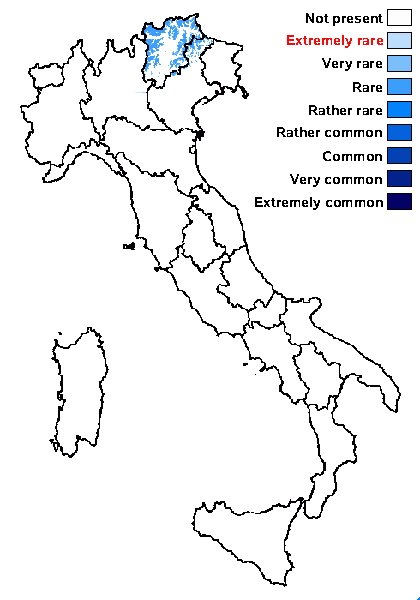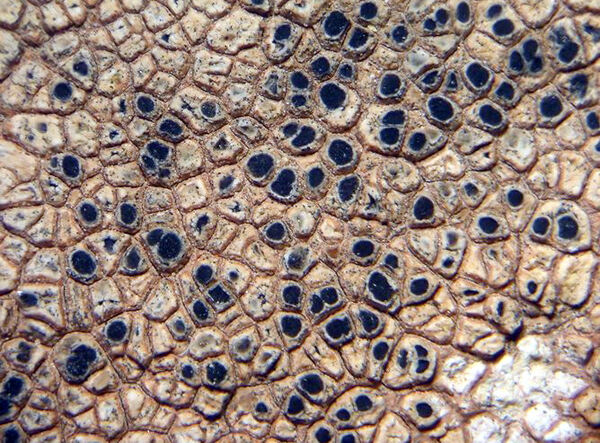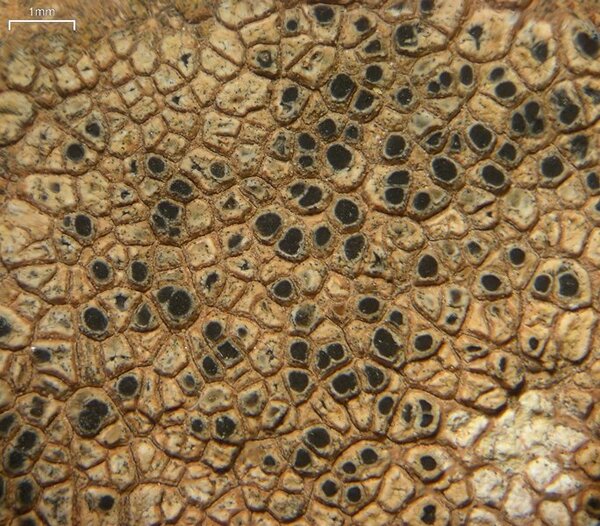Rinodina castanomela (Nyl.) Arnold
Verh. zool.-bot. Ges. Wien, 37: 121, 1887. Basionym: Lecanora castanomela Nyl. - Flora, 69: 99, 1886.
Synonyms:
Distribution: N - Ven (Nascimbene & al. 2021), TAA (Giralt & Llimona 1997, Nascimbene & al. 2022).
Description: Thallus crustose, episubstratic, rather thick, rimose-areolate, well-delimited but without a distinct prothallus, the areoles ochraceous brown to brown-black, more rarely grey to grey-brown, up to 1.2(-1.6) mm wide, usually flat, sometimes subumbilicate with free or upturned, lobate margins. Cortex paraplectenchymatous, overlain by a thick epinecral layer. Apothecia cryptolecanorine to lecanorine, subimmersed in the areoles, 1-2(-3) per areole, 0.7-0.85(-1) mm across, with a black, sometimes white-pruinose, flat to convex disc and a thin, entire and persistent or finally excluded thalline margin. Thalline exciple 85-200 µm thick laterally, corticate; proper exciple colourless, 10-15 µm thick laterally, expanding to 15-40 µm at the periphery; epithecium grey-brown to brown, K-; hymenium colourless, 70-120 µm high, usually inspersed with abundant oil droplets; paraphyses 1.5-2.5(-3.5) µm thick at mid-level, not strongly coherent, the apical cells 5.5-8 µm wide; hypothecium colourless or yellowish brown, inspersed with oil droplets, extending as a stipe into the medulla, up to 180 µm high. Asci 8-spored, clavate, the K/I+ blue tholus penetrated by a faintly amyloid apical cushion with parallel or diverging flanks, the wall K/I-, surrounded by a K/I+ blue outer layer, Lecanora-type. Ascospores 1-septate, pigmented, broadly ellipsoid, (15-)17-19(-22) x (7.5-)9-10.5(-12) µm, Bicincta-type, the pigmented bands sometimes poorly evident, the wall not ornamented, with spore ontogeny of type A (apical wall thickening after septum formation). Pycnidia black, immersed. Conidia bacilliform, 4-5 µm long. Photobiont chlorococcoid. Spot tests: K-, C-, KC-, P-, UV-. Chemistry: zeorin.Note: an arctic-alpine to boreal-montane, perhaps circumpolar lichen found under overhanging cliffs of weakly calcareous or basic siliceous rocks, marl and calciferous schist near or above treeline; perhaps more widespread in the Alps.
Growth form: Crustose
Substrata: rocks
Photobiont: green algae other than Trentepohlia
Reproductive strategy: mainly sexual
In underhangs rarely wetted by rain
Commonnes-rarity: (info)
Alpine belt: rare
Subalpine belt: very rare
Oromediterranean belt: absent
Montane belt: absent
Submediterranean belt: absent
Padanian area: absent
Humid submediterranean belt: absent
Humid mediterranean belt: absent
Dry mediterranean belt: absent

Predictive model
Herbarium samples
Growth form: Crustose
Substrata: rocks
Photobiont: green algae other than Trentepohlia
Reproductive strategy: mainly sexual
In underhangs rarely wetted by rain
Commonnes-rarity: (info)
Alpine belt: rare
Subalpine belt: very rare
Oromediterranean belt: absent
Montane belt: absent
Submediterranean belt: absent
Padanian area: absent
Humid submediterranean belt: absent
Humid mediterranean belt: absent
Dry mediterranean belt: absent

Predictive model
| Herbarium samples |
 INDEX FUNGORUM
INDEX FUNGORUM
 GBIF
GBIF
 DOLICHENS
DOLICHENS



